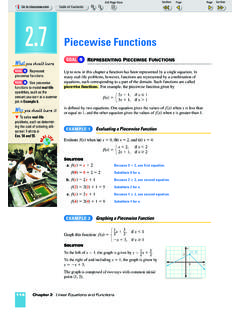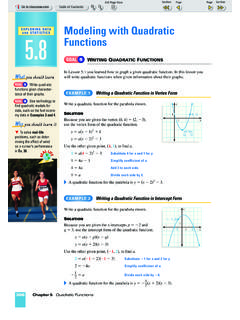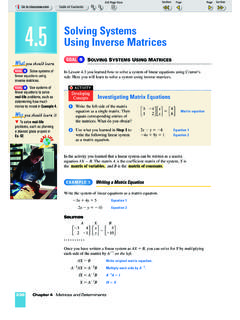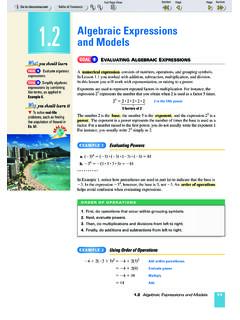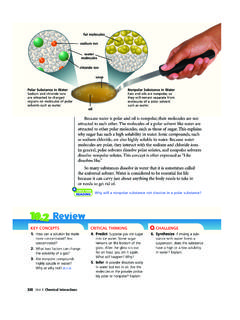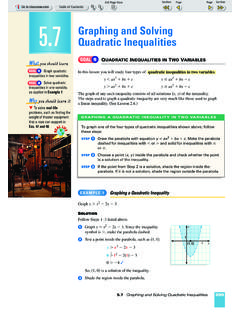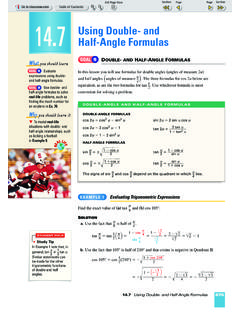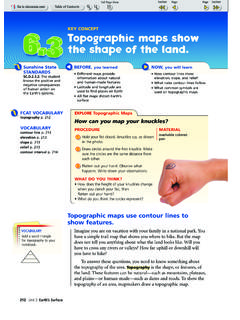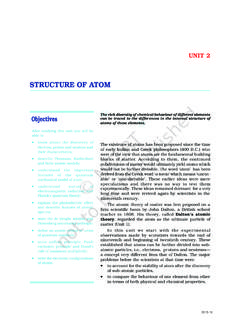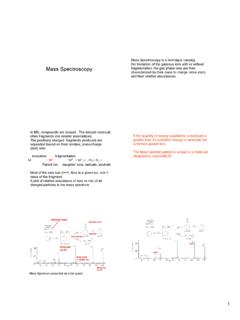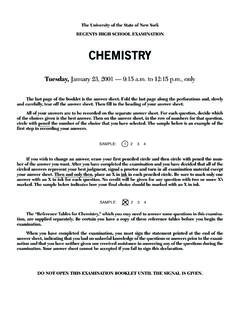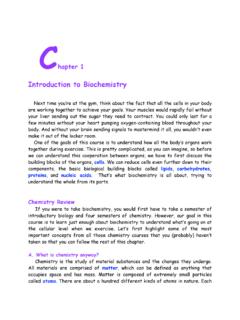Transcription of KEY CONCEPT Materials can become electrically charged.
1 KEY CONCEPT . Materials can become electrically charged . Sunshine State BEFORE, you learned NOW, you will learn STANDARDS Atoms are made up of How charged particles behave : The student particles called protons, How electric charges build up describes and com- neutrons, and electrons in Materials pares the properties of Protons and electrons are How static electricity is particles and waves. electrically charged used in technology : The student knows that technologi- cal design should require taking into account constraints such as natural laws, EXPLORE Static Electricity the properties of the Materials used, and How can Materials interact electrically ?
2 Economic, political, social, ethical, and PROCEDURE Materials . aesthetic values. 2 strips of 1 Hold the newspaper strips firmly together at newspaper one end and let the free ends hang down. plastic bag Observe the strips. VOCABULARY 2 Put the plastic bag over your other hand, electric charge p. 342 like a mitten. Slide the plastic down the electric field p. 342 entire length of the strips and then let go. static charge p. 343 Repeat several times. induction p. 345. 3 Notice how the strips of paper are hanging. Describe what you observe. WHAT DO YOU THINK? How did the strips behave before step 2? How did they behave after step 2?
3 How might you explain your observations? Electric charge is a property of matter. You are already familiar with electricity, static electricity, and magnetism. You know electricity as the source of power for many appliances, including lights, tools, and computers. Static electricity is what makes clothes stick together when they come out of a dryer and COMBINATION NOTES gives you a shock when you touch a metal doorknob on a dry, winter As you read this section, day. Magnetism can hold an invitation or report card on the door of write down important your refrigerator. ideas about electric charge and static You may not know, however, that electricity, static electricity, and charges.
4 Make sketches to help you remember magnetism are all related. All three are the result of a single property these concepts. of matter electric charge. Chapter 10: Electricity 341. The smallest unit of a material that still has the characteristics of that material is an atom or a molecule. A molecule is two or more atoms bonded together. Most of an atom's mass is concentrated in the nucleus at the center of the atom. The nucleus contains particles called protons and neutrons. Much smaller particles called electrons move at high speeds outside the nucleus. VOCABULARY Protons and electrons have electric charges. Electric charge is a Make a four square property that allows an object to exert an electric force on another diagram for the term electric charge and the object without touching it.
5 Recall that a force is a push or a pull. The other vocabulary terms space around a particle through which an electric charge can exert this in this section. force is called an electric field. The strength of the field is greater near the particle and weaker farther away. All protons have a positive charge (+), and all electrons have a negative charge ( ). Normally, an atom has an equal number of protons and electrons, so their charges balance each other, and the overall charge on the atom is neutral. FLORIDA particles with the same type of charge positive or negative are Content Review reminder said to have like charges, and particles with different charges have You studied some properties of matter in grade 6.
6 The unlike charges. particles with like charges repel each other, that is, they charge of a particle is push each other away. particles with unlike charges attract each other, another property of matter. or pull on each other. Electric Charge charged particles exert forces on each other through their electric fields. charged particles Electric charge can be either negative or positive. The balloon and the cat's fur have unlike charges, so they attract each other. 1 Attraction 2 Repulsion particles with unlike charges particles with like charges attract pull on each other. repel push each other away. = electron = proton = lines of force How do the force lines change when particles attract?
7 342 Unit 3: Electricity and Magnetism Static charges are caused by the movement of electrons. You have read that protons and electrons have electric charges. Objects reading tip and Materials can also have charges. A static charge is a buildup of The word static comes from the Greek word statos, electric charge in an object caused by the presence of many particles which means standing.. with the same charge. Ordinarily, the atoms that make up a material have a balance of protons and electrons. A material develops a static charge or becomes charged when it contains more of one type of charged particle than another. If there are more protons than electrons in a material , the material has a positive charge.
8 If there are more electrons than protons in a material , it has a negative charge. The amount of the charge depends on how many more electrons or protons there are. The total number of unbalanced positive or negative charges in an object is the net charge of the object. Net charge is measured in coulombs (KOO-LAHMZ). reminder One coulomb is equivalent to more than 1019 electrons or protons. 1019 is the same as 1. followed by 19 zeros. Electrons can move easily from one atom to another. Protons cannot. For this reason, charges in Materials usually result from the movement of electrons. The movement of electrons through a material is called conduction.
9 If electrons move from one atom to another, the atom they move to develops a negative charge. The atom they move away from develops a positive charge. Atoms with either a positive or a negative charge are called ions. A static charge can build up in an uncharged material when it touches or comes near a charged material . Static charges also build up when some types of uncharged Materials come into contact with each other. Charging by Contact When two uncharged objects made of certain Materials such as rubber and glass touch each other, electrons move from one material to the other. This process is called charging by contact.
10 It can be demonstrated by a balloon and a glass rod, as shown below. + +. + + + . +. + + . + . + + . +. 1 At first, a balloon 2 When they touch, 3 Afterwards, the bal- and a glass rod electrons move loon has a negative each have balanced, from the rod to charge, and the rod neutral charges. the balloon. has a positive charge. Chapter 10: Electricity 343. metal A Van de Graaff generator is a device that globe builds up a strong static charge through contact. This device is shown at left. At the bottom of the device, a rubber conveyer belt rubs against a metal brush and picks up electrons. At the top, the belt rubs against metal connected to the sphere, transferring electrons to the sphere.
